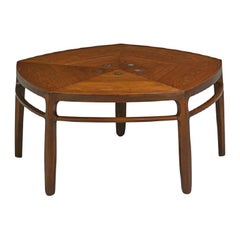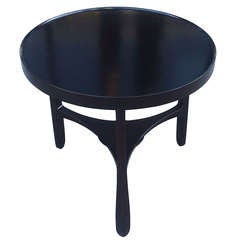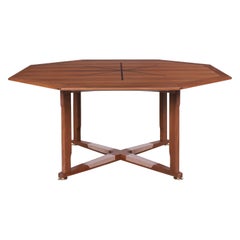Edward Wormley For Dunbar Round Janus Table
Vintage 1960s American Mid-Century Modern Coffee and Cocktail Tables
Walnut, Glass
Recent Sales
Vintage 1950s American Mid-Century Modern Center Tables
Walnut, Wood
Vintage 1950s American Mid-Century Modern Game Tables
Brass
Vintage 1950s American Game Tables
Brass
Vintage 1960s American Coffee and Cocktail Tables
Mahogany, Ceramic
People Also Browsed
2010s South African Minimalist Night Stands
Poplar, Burl
Vintage 1970s American Mid-Century Modern Benches
Mahogany
Vintage 1960s American Mid-Century Modern Side Tables
Burl
Vintage 1960s American Mid-Century Modern Benches
Mohair, Walnut
Vintage 1950s American Mid-Century Modern Lounge Chairs
Velvet, Wood
Vintage 1940s American Mid-Century Modern Armchairs
Mahogany
Vintage 1950s American Mid-Century Modern Shelves and Wall Cabinets
Walnut
Vintage 1940s American Mid-Century Modern Magazine Racks and Stands
Birch, Walnut
Early 20th Century American Art Nouveau Chandeliers and Pendants
Bronze
Vintage 1950s Mid-Century Modern Side Tables
Brass
Vintage 1950s American Mid-Century Modern Benches
Leather, Mahogany
Antique Early 1900s Austrian Art Nouveau Table Lamps
Brass
Vintage 1950s Cabinets
Mahogany
Vintage 1920s American Art Deco Armchairs
Birch
Vintage 1950s American Coffee and Cocktail Tables
Walnut
Vintage 1950s Mid-Century Modern Desk Accessories
Brass
Edward Wormley for sale on 1stDibs
As the longtime director of design for the Dunbar furniture company, Edward Wormley was, along with such peers as George Nelson at Herman Miller Inc., and Florence Knoll of Knoll Inc., one of the leading forces in bringing modern design into American homes in the mid-20th century. Not an axiomatic modernist, Wormley deeply appreciated traditional design, and consequently his vintage seating, storage cabinets, bar carts and other work has an understated warmth and a timeless quality that sets it apart from other furnishings of the era.
Wormley was born in rural Illinois and as a teenager took correspondence courses from the New York School of Interior Design. He later attended the Art Institute of Chicago but ran out of money for tuition before he could graduate. Marshall Field hired Wormley in 1930 to design a line of reproduction 18th-century English furniture; the following year he was hired by the Indiana-based Dunbar, where he quickly distinguished himself. It was a good match.
Dunbar was an unusual firm: it did not use automated production systems; its pieces were mostly hand-constructed. For his part, Wormley did not use metal as a major component of furniture; he liked craft elements such as caned seatbacks, tambour drawers, or the woven-wood cabinet fronts seen on his Model 5666 sideboard of 1956. He designed two lines for Dunbar each year — one traditional, one modern — until 1944, by which time the contemporary pieces had become the clear best sellers.
Many of Wormley’s signature pieces — chairs, sofas, tables and more — are modern interpretations of traditional forms. His 1946 Riemerschmid Chair — an example is in the collection of the Museum of Modern Art — recapitulates a late 19th-century German design. The long, slender finials of his Model 5580 dining chairs are based on those of Louis XVI chairs; his Listen-to-Me Chaise (1948) has a gentle Rococo curve; the “Precedent” line that Wormley designed for Drexel Furniture in 1947 is a simplified, pared-down take on muscular Georgian furniture. But he could invent new forms, as his Magazine table of 1953, with its bent wood pockets, and his tiered Magazine Tree (1947), both show. And Wormley kept his eye on design currents, creating a series of tables with tops that incorporate tiles and roundels by the great modern ceramicists Otto and Gertrud Natzler.
As the vintage items on 1stDibs demonstrate, Edward Wormley conceived of a subdued sort of modernism, designing furniture that fits into any decorating scheme and does not shout for attention.
Finding the Right Tables for You
The right vintage, new or antique tables can help make any space in your home stand out.
Over the years, the variety of tables available to us, as well as our specific needs for said tables, has broadened. Today, with all manner of these must-have furnishings differing in shape, material and style, any dining room table can shine just as brightly as the guests who gather around it.
Remember, when shopping for a dining table, it must fit your dining area, and you need to account for space around the table too — think outside the box, as an oval dining table may work for tighter spaces. Alternatively, if you’ve got the room, a Regency-style dining table can elevate any formal occasion at mealtime.
Innovative furniture makers and designers have also redefined what a table can be. Whether it’s an unconventional Ping-Pong table, a brass side table to display your treasured collectibles or a Louis Vuitton steamer trunk to add an air of nostalgia to your loft, your table can say a lot about you.
The visionary work of French designer Xavier Lavergne, for example, includes tables that draw on the forms of celestial bodies as often as they do aquatic creatures or fossils. Elsewhere, Italian architect Gae Aulenti, who looked to Roman architecture in crafting her stately Jumbo coffee table, created clever glass-topped mobile coffee tables that move on bicycle tires or sculpted wood wheels for Fontana Arte.
Coffee and cocktail tables can serve as a room’s centerpiece with attention-grabbing details and colors. Glass varieties will keep your hardwood flooring and dazzling area rugs on display, while a marble or stone coffee table in a modern interior can showcase your prized art books and decorative objects. A unique vintage desk or writing table can bring sophistication and even a bit of spice to your work life.
No matter your desired form or function, a quality table for your living space is a sound investment. On 1stDibs, browse a collection of vintage, new and antique bedside tables, mid-century end tables and more .


